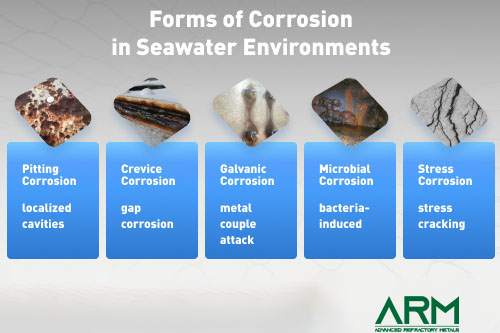What You Should Know about Corrosion Resistant Metals

Corrosion is a widespread problem with both substantial economic and safety implications. It costs more than $2.5 trillion annually worldwide across all industries, roughly equivalent to almost 3–4% of world GDP. In just the marine industry, corrosion failure causes tons of metal loss and repeated structure replacement. Stress corrosion cracking in pipelines has resulted in cataclysmic accidents, i.e., oil leakage and chemical spillage, whereas pitting corrosion of offshore structures can destabilize integrity in spite of submicron damage.
Awareness of corrosion, correct choice of metal, and adoption of protective measures are significant in the sense that they should prevent economic losses, environmental disasters, and safety hazards.

Corrosion Mechanisms in Different Forms of Corrosion
Metals very rarely fail uniformly.
- There exist very small but deep pits that penetrate the metal within hours under extreme chloride conditions in pitting corrosion.
- There is crevice corrosion that occurs in sheltered crevices where solution stagnation accelerates metal degradation.
- Galvanic corrosion occurs when two unlike metals are in contact with an electrolytic liquid, and the less noble metal corrodes at an accelerated rate.
- Stress corrosion cracking is the synergism of tensile stress and corrosive environment and most often is the reason for the catastrophic fracture in material structure.
- Microbial corrosion is microbially induced, and microbial corrosion causes instantaneous deterioration of pipelines, tanks, and seawater equipment.
Role of Alloying Elements in Corrosion Resistance
Alloying elements provide major corrosion performance.
Chromium (Cr) forms a protective oxide layer on steel that is rust resistant. Nickel (Ni) likes chemical stability and hardness. Molybdenum (Mo) increases pitting and crevice corrosion resistance particularly in chloride media. Aluminum (Al) forms a protective oxide layer, which is light and corrosion resistant. These metals alloyed in engineered alloys can resist harsh conditions, reducing maintenance expenses and increasing service life.
List of Corrosion Resistant Metals
1. Stainless Steel: Austenitic alloys like 304 and 316 contain 18–25% Cr and 8–12% Ni. Grade 316, with the inclusion of Mo, is resistant to chloride corrosion and used in marine hardware applications, chemical storage tanks, and surgical tools. Martensitic 420A is high-strength (~700 MPa) but lacks corrosion resistance and used in shafts and knives. S32750 (25% Cr, 7% Ni, 4% Mo) duplex type is used under harsh conditions, like offshore platforms.
2. Titanium: Grade 5 (Ti-6Al-4V) is 40% lighter than steel but comparable with high-strength steels (~900 MPa tensile). It has a passive oxide coating resistant to chlorides and acids and thus occurs in aerospace applications, desalination plants, and implants.
3. Aluminum: 1xxx series (approximately 99% Al) is very corrosion-resistant for roofing and panel uses. 3xxx (Al-Mn, up to 1.25% Mn) has a compromise between corrosion protection and ductility for motor vehicle body panels and beer cans. 5xxx (Al-Mg) is resistant to pitting in seawater. Anodizing provides additional surface protection.
4. Copper Alloys: Bronze (88% Cu, 12% Sn) is corrosion resistant in atmosphere and seawater and widely employed in bearings and marine fittings. Brass (Cu-Zn with trace Sn) possesses corrosion resistance combined with mechanical strength and finds applications in valves, electrical terminals, and fittings.
How to Fight against Corrosion
Surface treatments extend the life of metals. Anodizing thickens aluminum's oxide film naturally, extending wear and chemical resistance. Nickel or zinc plating shields metals from atmospheric corrosion. Paint and polymer coatings offer seals against water, salt, and chemicals. Employing coatings with corrosion-resistant alloys offers the highest protection in industrial and marine atmospheres.
Corrosion Testing Methods
Standardized testing predicts long-term performance. Salt spray tests simulate sea exposure. Electrochemical reactions test corrosion rates at controlled potentials. Accelerated weathering tests subject materials to UV, water, and temperature cycling to simulate decades of exposure. These tests help to aid in material selection, protective coatings, and maintenance schedules.
Applications of Corrosion Resistance in Different Fields
Corrosion resistance is needed by all industries. Seawater is exposed at all times to ships, offshore platforms, and pipelines. Automotive and aviation components resist weathering, road salts, and mechanical loads. Construction materials rely on corrosion-resistant metals to endure and appear best, and electronics require protective coatings so that they can carry electricity and not oxidize.
Factors Affecting Corrosion Resistance
Environmental conditions do more than just affect corrosion. They actually increase corrosion. Temperature increases chemical reaction rates, and humidity increases surface wetness, thus facilitating electrochemical reactions. Acidic or chloride conditions increase metal loss even further. Engineers can come up with condition-specific alloys, coatings, and maintenance approaches by understanding these factors.
Conclusion
Effective corrosion control is the comprehension of mechanisms, appropriate selection of metal, and deployment of protective measures. With the use of stainless steel, titanium, aluminum, copper alloys, and high-performance coatings, industries can prevent catastrophic failures, reduce maintenance costs, and optimize the longevity of mission-critical components subjected to extreme conditions.
{{item.content}}
LEVE A REPLY
{{item.children[0].content}}
{{item.content}}






